Discovery of Dolutegravir Derivative against Liver Cancer via Inducing Autophagy and DNA Damage
Abstract
:1. Introduction
2. Chemistry
3. Results and Discussion
3.1. Dolutegravir Derivatives Suppressed Cancer Cell Viability
3.2. Compounds 5e and 5p Inhibited Proliferation of Cancer Cells
3.3. Compounds 5e and 5p Induced Apoptosis of Cancer Cells
3.4. Compounds 5e and 5p Changed Cell Cycle in Cancer Cells
3.5. Compounds 5e and 5p Triggered Reactive Oxygen Species Generation in Cancer Cell Lines
3.6. Compounds 5e and 5p Affected Protein Expressions of Key Signaling Pathways
3.7. Compounds 5e and 5p Cause DNA Damage in Huh7 and HepG2 Cells
3.8. In Vivo Toxicity of Compound 5e to Mice
4. Experimental
4.1. Materials and Chemistry
General Synthetic Route of the Dolutegravir Derivatives
4.2. Biological Study
4.2.1. Cell Culture
4.2.2. Cell Viability Assay
4.2.3. Live and Dead Cell Measurement
4.2.4. Plate Clone Formation Assay
4.2.5. Apoptosis Assay
4.2.6. Cell Cycle Assay
4.2.7. Cellular ROS Measurement
4.2.8. Western Blot
4.2.9. DNA Damage Staining
4.2.10. Statistical Analyses
5. Conclusions
Supplementary Materials
Author Contributions
Funding
Institutional Review Board Statement
Informed Consent Statement
Data Availability Statement
Conflicts of Interest
References
- Biggar, R.J.; Chaturvedi, A.K.; Goedert, J.J.; Engels, E.A. AIDS-Related Cancer and Severity of Immunosuppression in Persons with AIDS. JNCI J. Natl. Cancer Inst. 2007, 99, 962–972. [Google Scholar] [CrossRef] [PubMed]
- Piketty, C.; Selinger-Leneman, H.; Bouvier, A.-M.; Belot, A.; Mary-Krause, M.; Duvivier, C.; Bonmarchand, M.; Abramowitz, L.; Costagliola, D.; Grabar, S. Incidence of HIV-Related Anal Cancer Remains Increased Despite Long-Term Combined Antiretroviral Treatment: Results from the French Hospital Database on HIV. J. Clin. Oncol. 2012, 30, 4360–4366. [Google Scholar] [CrossRef]
- Chen, L.; Feng, Z.; Yue, H.; Bazdar, D.; Mbonye, U.; Zender, C.; Harding, C.V.; Bruggeman, L.; Karn, J.; Sieg, S.F.; et al. Exosomes derived from HIV-1-infected cells promote growth and progression of cancer via HIV TAR RNA. Nat. Commun. 2018, 9, 4585. [Google Scholar] [CrossRef] [PubMed]
- Craigie, R. HIV integrase, a brief overview from chemistry to therapeutics. J. Biol. Chem. 2001, 276, 23213–23216. [Google Scholar] [CrossRef] [PubMed]
- Ratcliffe, L.; Beadsworth, M.B.; Pennell, A.; Phillips, M.; Vilar, F.J. Managing hepatitis B/HIV co-infected: Adding entecavir to truvada (tenofovir disoproxil/emtricitabine) experienced patients. Aids 2011, 25, 1051–1056. [Google Scholar] [CrossRef] [PubMed]
- Ward, A.S.; Hsiung, C.H.; Kesterson, D.G.; Kamath, V.G.; McKee, E.E. Entecavir competitively inhibits deoxyguanosine and deoxyadenosine phosphorylation in isolated mitochondria and the perfused rat heart. J. Biol. Chem. 2022, 5, 298. [Google Scholar] [CrossRef] [PubMed]
- Crum-Cianflone, N.; Dilay, A.; Collins, G.; Asher, D.; Campin, R.; Medina, S.; Goodman, Z.; Parker, R.; Lifson, A.; Capozza, T.; et al. Nonalcoholic fatty liver disease among HIV-infected persons. J. Acquir. Immune Defic. Syndr. 2009, 50, 464. [Google Scholar] [CrossRef] [PubMed]
- Santos, M.; Corma-Gómez, A.; Fernandez-Fuertes, M.; González-Serna, A.; Rincón, P.; Real, L.; Pineda, J.; Macías, J. Burden of significant liver damage in people living with HIV after microelimination of the hepatitis C virus. J. Infect. 2023, 86, 41–46. [Google Scholar] [CrossRef] [PubMed]
- Ragni, M.V.; Eghtesad, B.; Schlesinger, K.W.; Dvorchik, I.; Fung, J.J. Pre-trasnplant survival is shorter in HIV-positive than HIV-negative with end-stage liver disease. Liver Transplant. 2005, 11, 1425–1430. [Google Scholar] [CrossRef] [PubMed]
- Rallón, N.I.; Barreiro, P.; Soriano, V.; García-Samaniego, J.; López, M.; Benito, J.M. Elevated TGF-β1 levels might protect HCV/HIV-coinfected patients from liver fibrosis. Eur. J. Clin. Investig. 2011, 41, 70–76. [Google Scholar] [CrossRef] [PubMed]
- Bourcier, V.; Winnock, M.; Ait Ahmed, M.; Sogni, P.; Pambrun, E.; Poizot-Martin, I.; Chaffaut, C.; Chevret, S.; Trinchet, J.C.; Salmon, D.; et al. Primary liver cancer is more aggressive in HIV-HCV coinfection than in HCV infection. A prospective study (ANRS CO13 Hepavih and CO12 Cirvir). Clin. Res. Hepatol. Gastroenterol. 2012, 36, 214–221. [Google Scholar] [CrossRef] [PubMed]
- Trivedi, J.; Mahajan, D.; Jaffe, R.J.; Acharya, A.; Mitra, D.; Byrareddy, S.N. Recent Advances in the Development of Integrase Inhibitors for HIV Treatment. Curr. HIV/AIDS Rep. 2020, 17, 63–75. [Google Scholar] [CrossRef] [PubMed]
- Johns, B.A.; Kawasuji, T.; Weatherhead, J.G.; Taishi, T.; Temelkoff, D.P.; Yoshida, H.; Akiyama, T.; Taoda, Y.; Murai, H.; Kiyama, R.; et al. Carbamoyl pyridone HIV-1 integrase inhibitors 3. A diastereomeric approach to chiral nonracemic tricyclic ring systems and the discovery of dolutegravir (S/GSK1349572) and (S/GSK1265744). J. Med. Chem. 2013, 56, 5901–5916. [Google Scholar] [CrossRef] [PubMed]
- Eron, J.J.; Clotet, B.; Durant, J.; Katlama, C.; Kumar, P.; Lazzarin, A.; Poizot-Martin, I.; Richmond, G.; Soriano, V.; Ait-Khaled, M.; et al. Safety and Efficacy of Dolutegravir in Treatment-Experienced Subjects with Raltegravir-Resistant HIV Type 1 Infection: 24-Week Results of the VIKING Study. J. Infect. Dis. 2013, 207, 740–748. [Google Scholar] [CrossRef]
- Cook, N.J.; Li, W.; Berta, D.; Badaoui, M.; Ballandras-Colas, A.; Nans, A.; Kotecha, A.; Rosta, E.; Engelman, A.N.; Cherepanov, P. Structural basis of second-generation HIV integrase inhibitor action and viral resistance. Science 2020, 367, 806. [Google Scholar] [CrossRef] [PubMed]
- Zhang, G.Y.; Zhang, Z.; Li, K.; Liu, J.; Li, B.; Jin, Z.; Liu, Y.H.; Tang, Y.Z. Design, synthesis and biological evaluation of novel pleuromutilin derivatives containing piperazine and 1,2,3-triazole linker. Bioorg. Chem. 2020, 105, 104398. [Google Scholar] [CrossRef]
- Macan, A.M.; Perin, N.; Jakopec, S.; Mioč, M.; Stojković, M.R.; Kralj, M.; Hranjec, M.; Raić-Malić, S. Synthesis, antiproliferative activity and DNA/RNA-binding properties of mono- and bis-(1,2,3-triazolyl)-appended benzimidazo [1,2-a]quinoline derivatives. Eur. J. Med. Chem. 2020, 185, 111845. [Google Scholar] [CrossRef]
- Sun, L.; Huang, T.; Dick, A.; Meuser, M.E.; Zalloum, W.A.; Chen, C.-H.; Ding, X.; Gao, P.; Cocklin, S.; Lee, K.-H.; et al. Design, synthesis and structure-activity relationships of 4-phenyl-1H-1,2,3-triazole phenylalanine derivatives as novel HIV-1 capsid inhibitors with promising antiviral activities. Eur. J. Med. Chem. 2020, 190, 112085. [Google Scholar] [CrossRef] [PubMed]
- Röhrig, U.F.; Reynaud, A.; Majjigapu, S.R.; Vogel, P.; Pojer, F.; Zoete, V. Inhibition Mechanisms of Indoleamine 2,3-Dioxygenase 1 (IDO1). J. Med. Chem. 2019, 62, 8784–8795. [Google Scholar] [CrossRef] [PubMed]
- Asemanipoor, N.; Mohammadi-Khanaposhtani, M.; Moradi, S.; Vahidi, M.; Asadi, M.; Faramarzi, M.A.; Mahdavi, M.; Biglar, M.; Larijani, B.; Hamedifar, H.; et al. Synthesis and biological evaluation of new benzimidazole-1,2,3-triazole hybrids as potential alpha-glucosidase inhibitors. Bioorganic Chem. 2020, 95, 103482. [Google Scholar] [CrossRef]
- Li, Y.N.; Liu, T.; Sun, J.N. Recent Advances in N-Heterocyclic Small Molecules for Synthesis and Application in Direct Fluorescence Cell Imaging. Molecules 2023, 28, 733. [Google Scholar]
- Sankareswaran, S.; Mannam, M.; Chakka, V.; Mandapati, S.R.; Kumar, P. Identification and Control of Critical Process Impurities: An Improved Process for the Preparation of Dolutegravir Sodium. Org. Process Res. Dev. 2016, 20, 1461–1468. [Google Scholar] [CrossRef]
- Wang, X.; Chen, S.; Zhao, C.; Long, L.; Wang, Y. Preparation of Dolutegravir Intermediate Diastereomer. J. Heterocycl. Chem. 2019, 56, 2063–2067. [Google Scholar]
- Pugh, J.C.; Yaginuma, K.; Koike, K.; Summers, J. Duck hepatitis B virus (DHBV) particles produced by transient expression of DHBV DNA in a human hepatoma cell line are infectious in vitro. J. Virol. 1988, 62, 3513. [Google Scholar] [CrossRef] [PubMed]
- Morris, K.M.; Aden, D.P.; Knowles, B.B.; Colten, H.R. Complement biosynthesis by the human hepatoma-derived cell line HepG2. Mol. Immunol. 1982, 19, 906–913. [Google Scholar] [CrossRef]
- Hua, J.; Wei, X.; Li, Y.; Li, L.; Zhang, H.; Wang, F.; Zhang, C.; Ma, X. A Cyclen-Functionalized Cobalt-Substituted Sandwich-Type Tungstoarsenate with Versatility in Removal of Methylene Blue and Anti-ROS-Sensitive Tumor Cells. Molecules 2022, 27, 6451. [Google Scholar] [CrossRef] [PubMed]
- Wang, W.J.; Mao, L.F.; Lai, H.L.; Wang, Y.W.; Jiang, Z.B.; Li, W.; Huang, J.M.; Xie, Y.J.; Xu, C.; Liu, P.; et al. Dolutegravir derivative inhibits proliferation and induces apoptosis of non-small cell lung cancer cells via calcium signaling pathway. Pharmacol. Res. 2020, 161, 105129. [Google Scholar] [CrossRef]

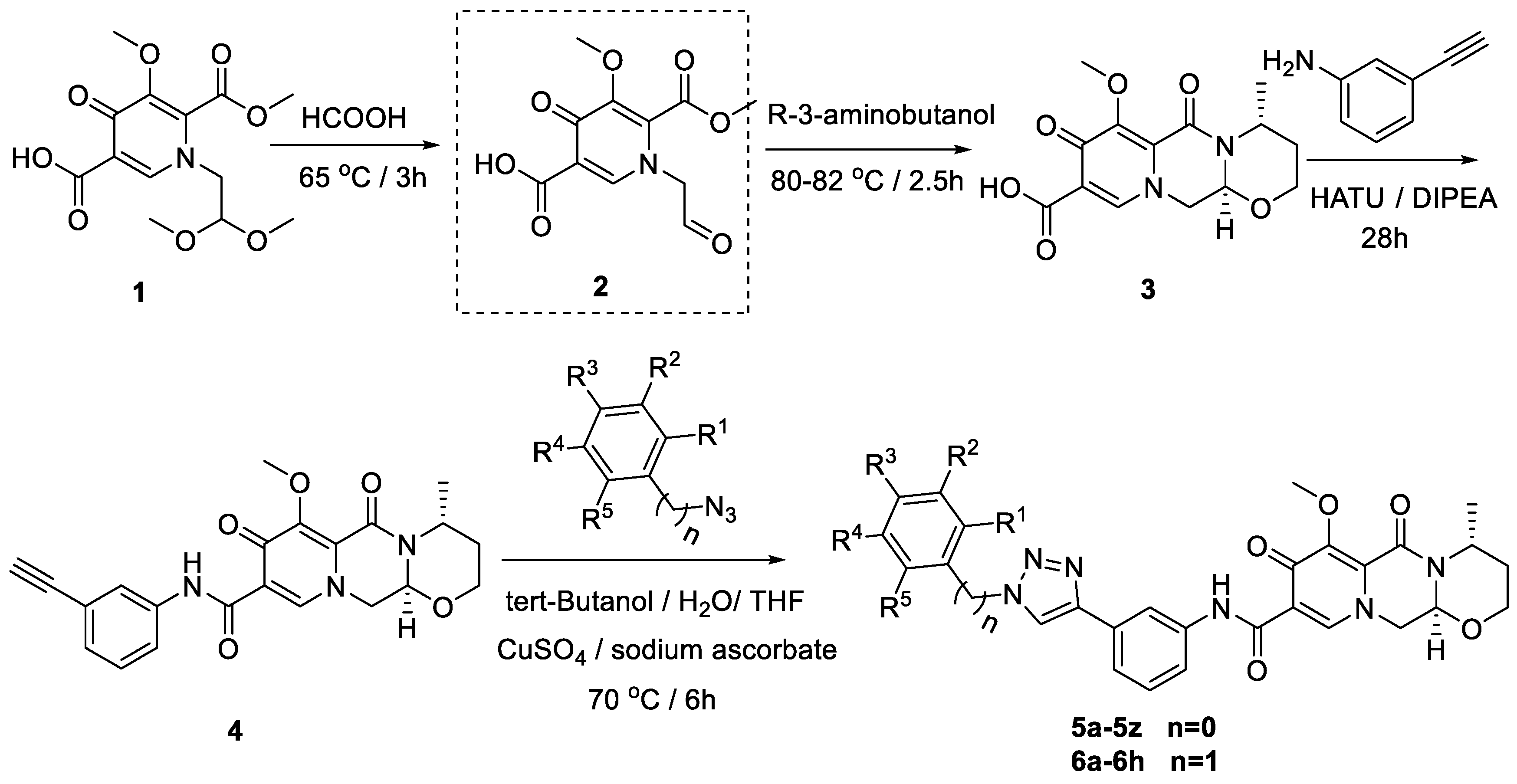
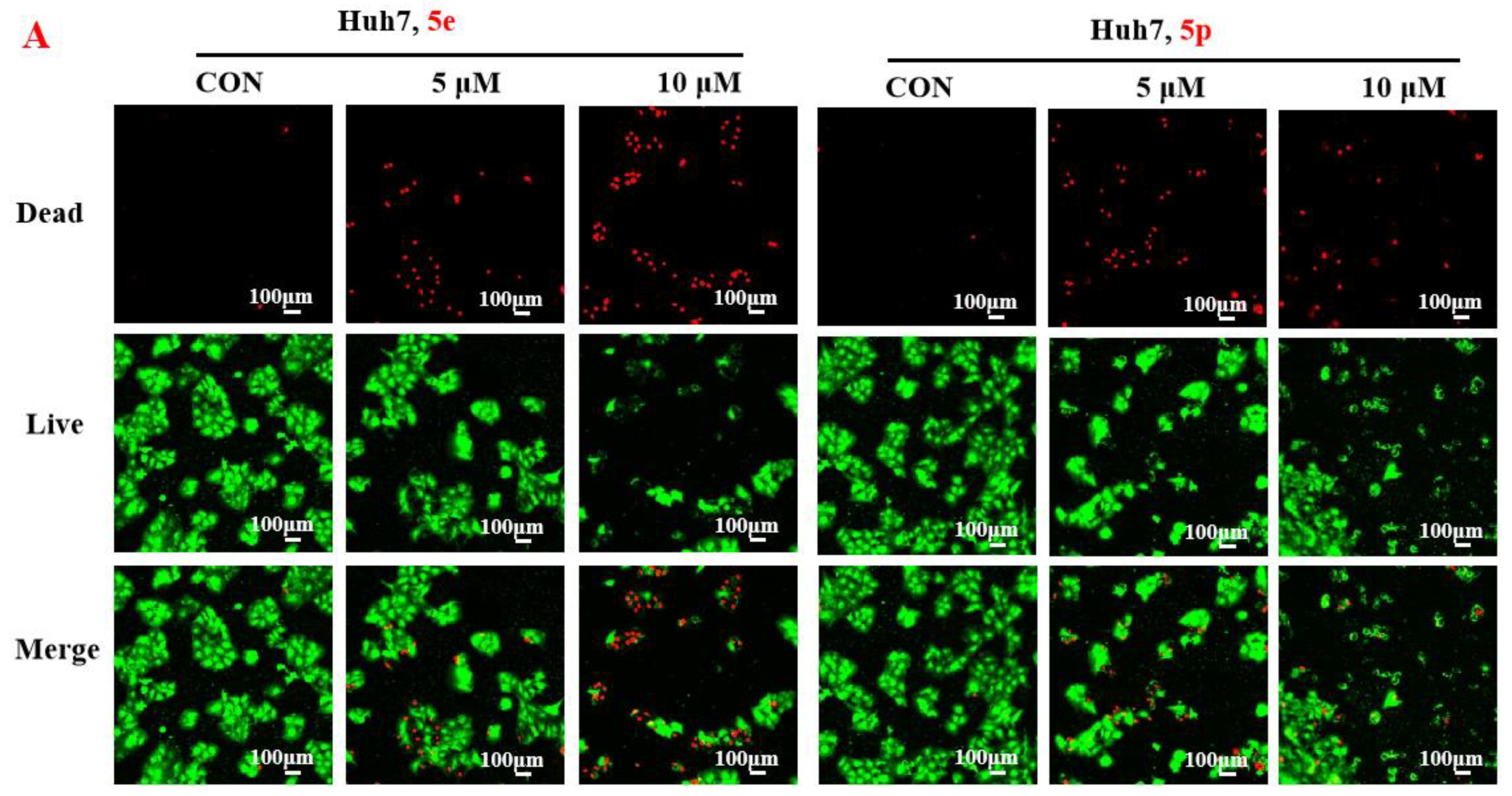
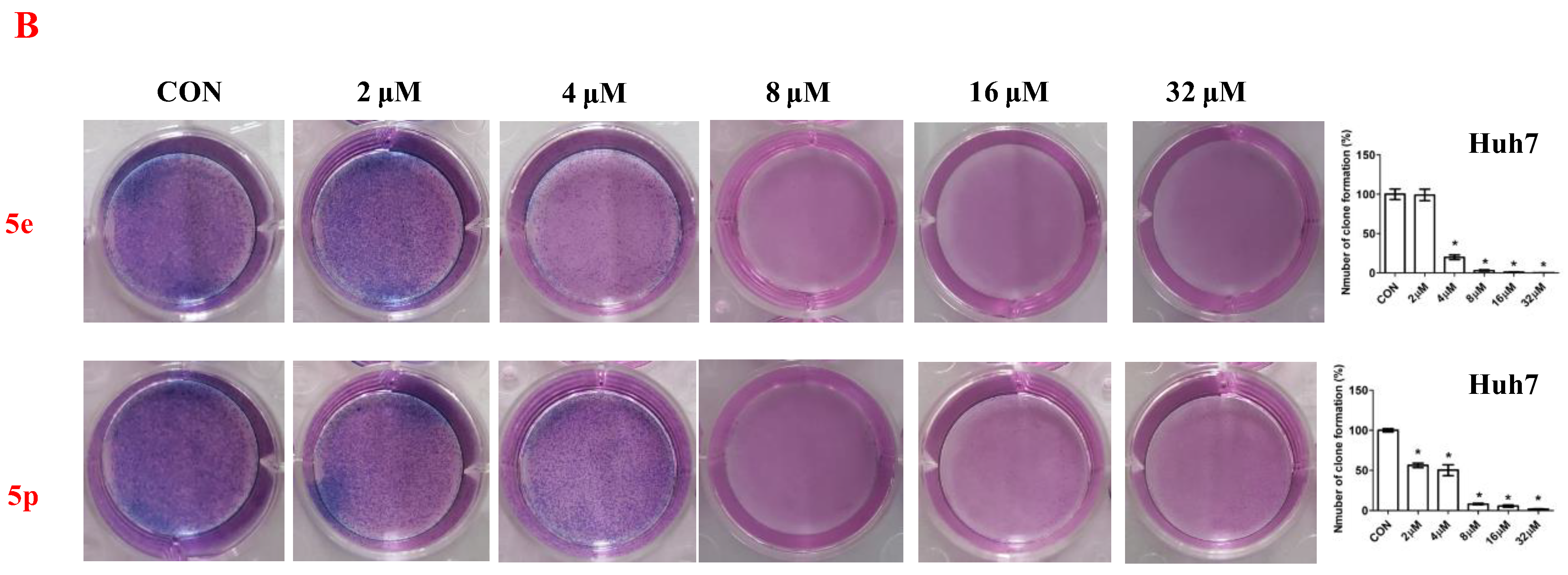


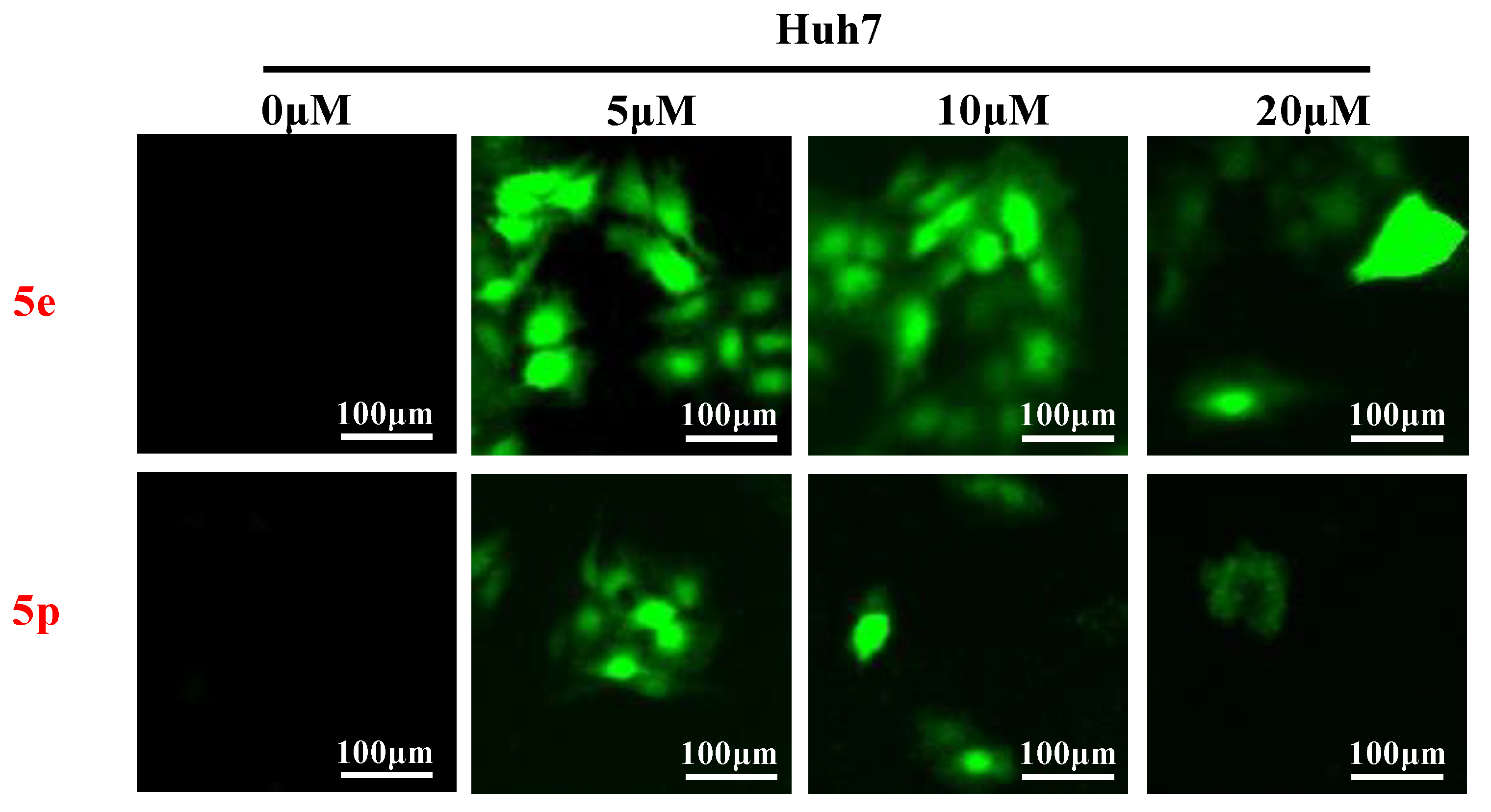
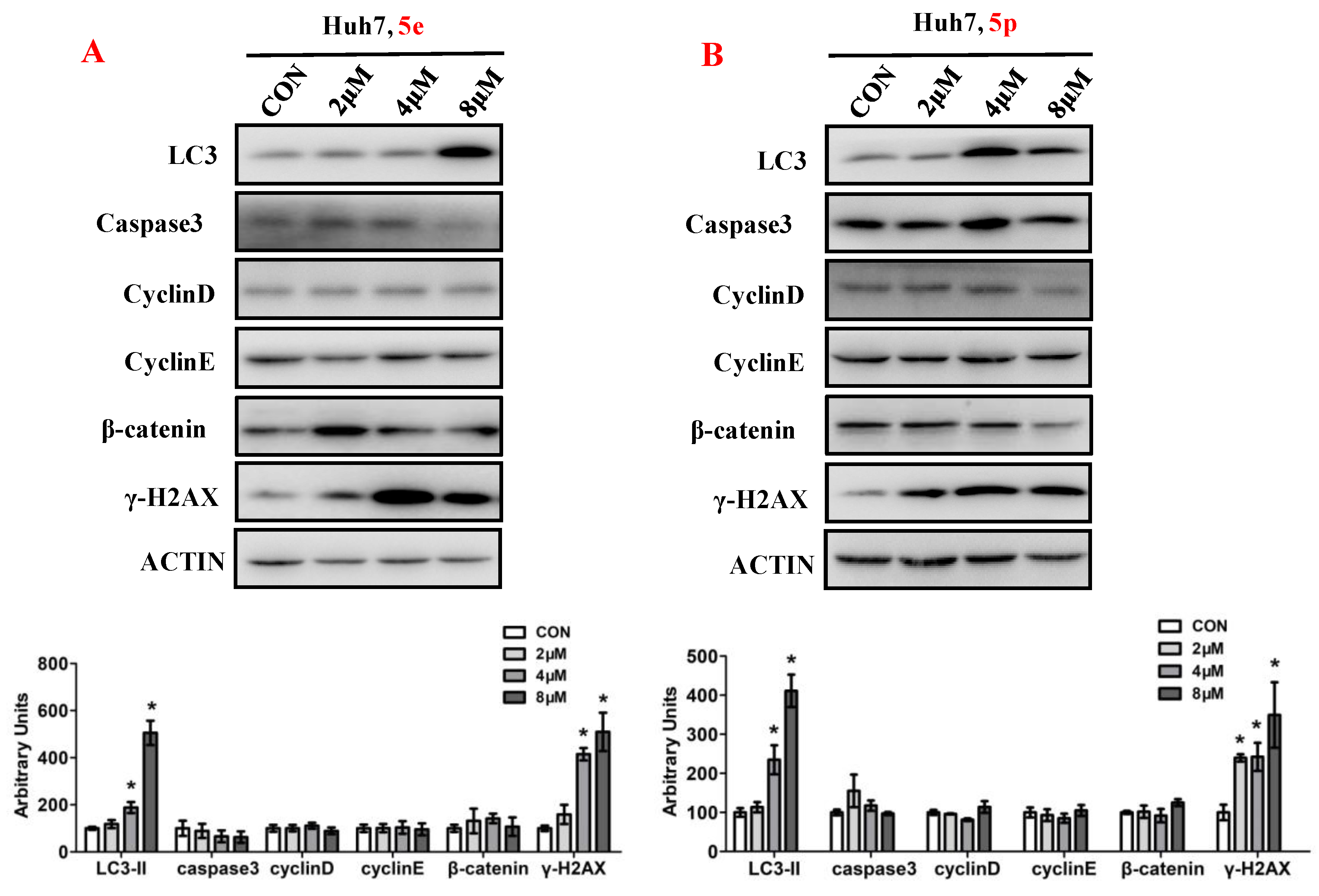
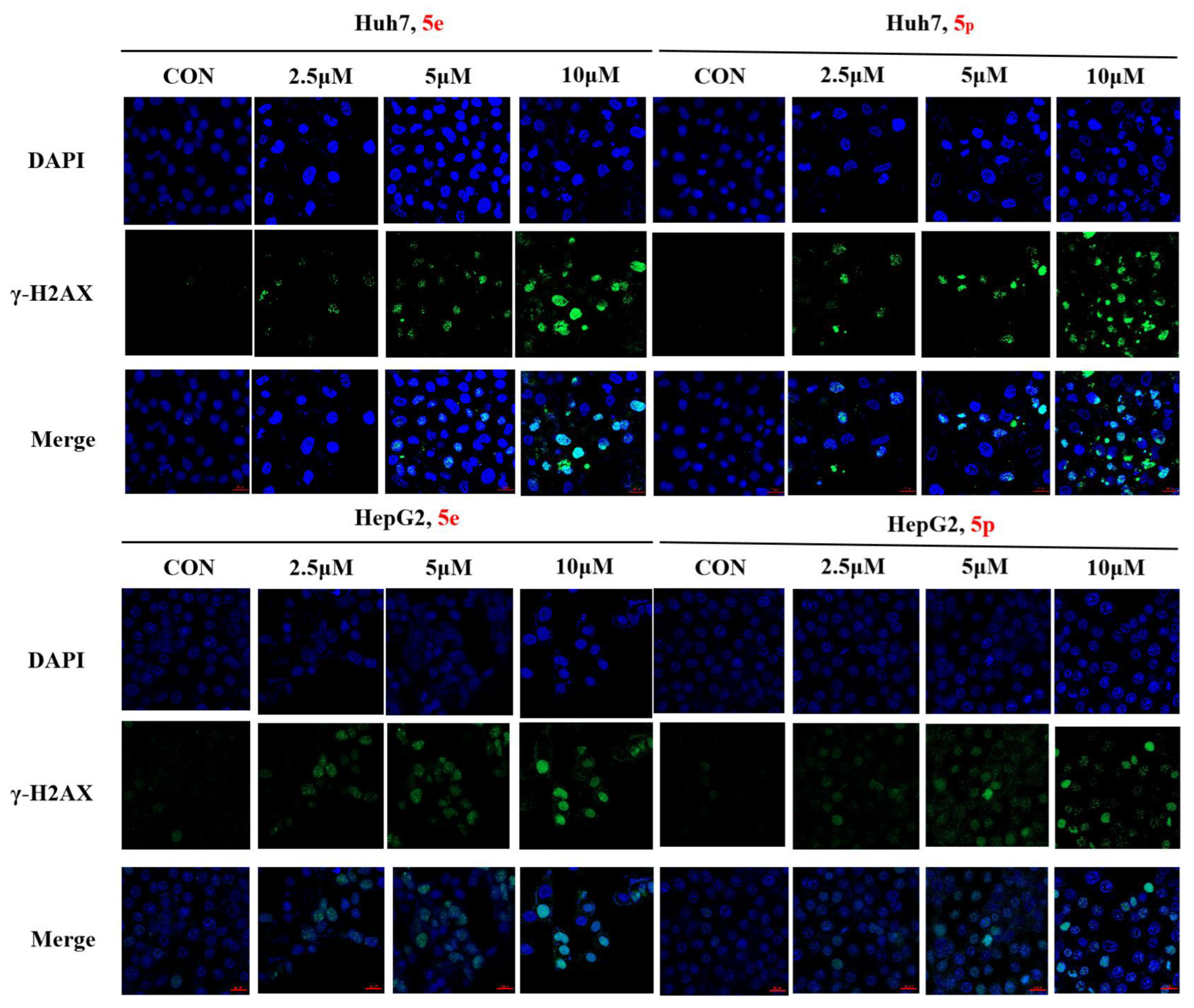
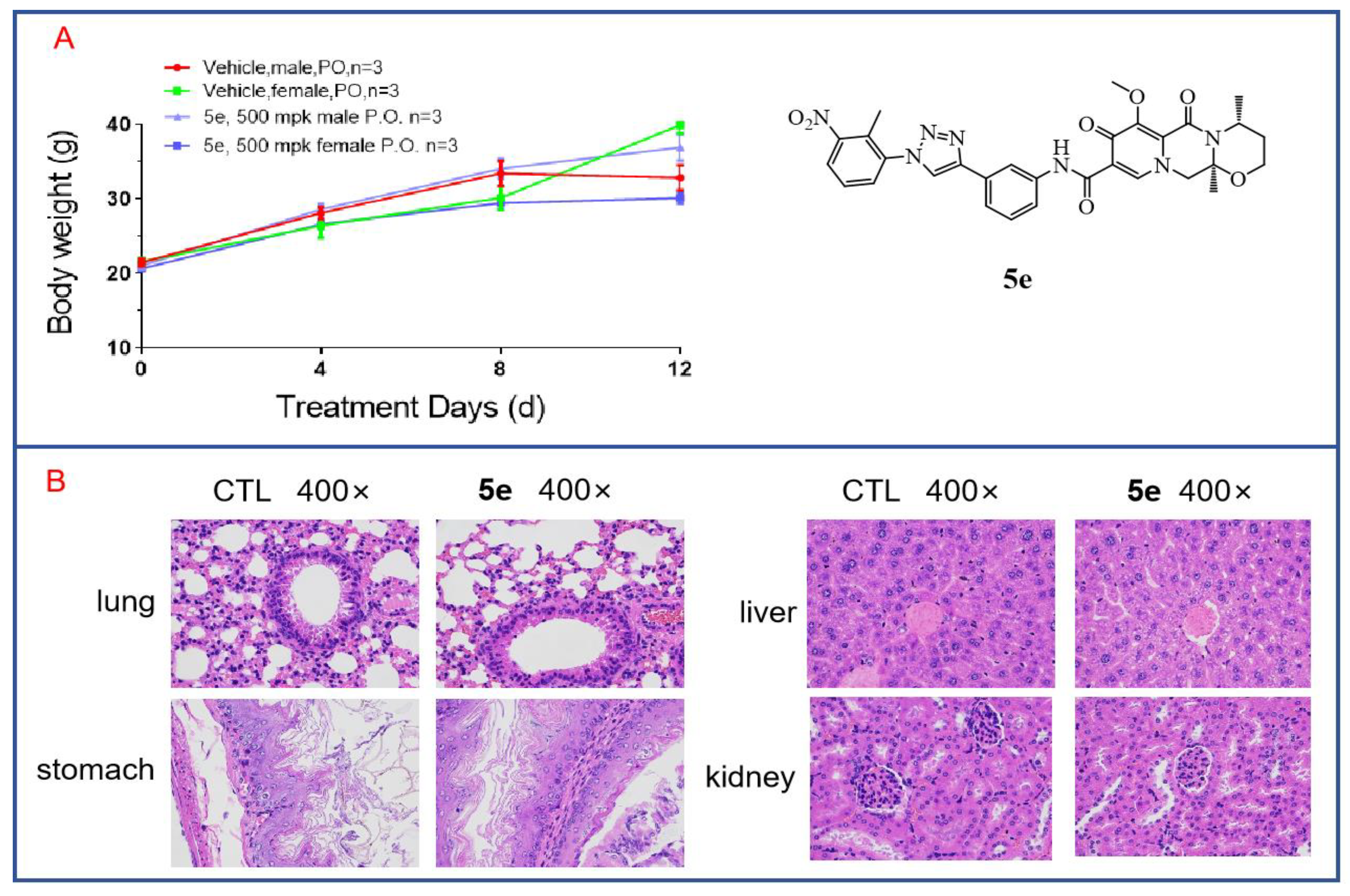
| Compd No. | R1 | R2 | R3 | R4 | R5 |
|---|---|---|---|---|---|
| 5a | F | H | H | H | H |
| 5b | OCH3 | H | NO2 | H | H |
| 5c | CF3 | H | H | H | H |
| 5d | H | H | CF3 | H | H |
| 5e | CH3 | NO2 | H | H | H |
| 5f | H | CH3 | H | H | H |
| 5g | H | H | F | H | H |
| 5h | H | H | OCH2CH3 | H | H |
| 5i | OCF3 | H | H | H | H |
| 5j | H | OCH3 | OCH3 | H | H |
| 5k | CH2CH3 | H | H | H | H |
| 5l | H | OCH3 | H | H | H |
| 5m | H | H | CH2CH3 | H | H |
| 5n | H | H | C(CH3)3 | H | H |
| 5o | H | H | H | H | H |
| 5p | H | CF3 | H | H | H |
| 5q | CF3 | H | H | CF3 | H |
| 5r | H | CF3 | H | CF3 | H |
| 5s | CH3 | H | H | H | H |
| 5t | OCH3 | H | H | H | H |
| 5u | Br | H | H | H | H |
| 5v | Cl | H | H | H | H |
| 5w | I | H | H | H | H |
| 5s | H | H | OCH3 | H | H |
| 5y | H | H | CH3 | H | H |
| 5z | CH3 | H | CH3 | H | CH3 |
| 6a | H | Br | H | Br | H |
| 6b | H | H | H | H | H |
| 6c | Br | H | H | H | H |
| 6d | H | OCH3 | H | H | H |
| 6e | H | Br | H | H | H |
| 6f | F | H | H | H | H |
| 6g | CH3 | H | H | H | H |
| 6h | CF3 | H | H | H | H |
| Compd No. | Cell Viability (100%), 20 μM, 48 h | ||
|---|---|---|---|
| Huh7 | hepG2 | HRM | |
| 5a | 83.32 | 90.43 | 71.18 |
| 5b | 110.94 | 93.94 | 112.94 |
| 5c | 36.28 | 54.14 | 2.65 |
| 5d | 77.89 | 79.96 | 108.43 |
| 5e | 33.91 | 39.65 | 85.04 |
| 5f | 15.92 | 12.96 | 66.43 |
| 5g | 90.24 | 105.19 | 103.67 |
| 5h | 72.06 | 90.41 | 102.23 |
| 5i | 7.95 | 24.84 | 70.03 |
| 5j | 65.52 | 77.13 | 108.54 |
| 5k | 48.55 | 50.62 | 0.81 |
| 5l | 46.30 | 33.91 | 94.97 |
| 5m | 36.41 | 77.30 | 101.13 |
| 5n | 54.04 | 77.30 | 108.06 |
| 5o | 67.64 | 80.21 | 100.28 |
| 5p | 5.93 | 30.66 | 16.33 |
| 5q | 12.00 | 38.49 | 91.40 |
| 5r | 80.13 | 78.52 | 101.27 |
| 5s | 61.76 | 69.61 | 100.81 |
| 5t | 29.33 | 41.93 | 73.24 |
| 5u | 33.46 | 47.16 | 100.10 |
| 5v | 37.66 | 38.75 | 95.10 |
| 5w | 49.87 | 54.35 | 92.77 |
| 5s | 68.32 | 66.93 | 101.55 |
| 5y | 79.52 | 69.40 | 103.82 |
| 5z | 66.22 | 63.22 | 100.35 |
| 6a | 75.97 | 66.48 | 84.46 |
| 6b | 68.00 | 57.81 | 99.53 |
| 6c | 39.13 | 46.80 | 105.55 |
| 6d | 72.78 | 65.65 | 98.59 |
| 6e | 20.45 | 55.14 | 102.27 |
| 6f | 54.58 | 63.23 | 102.19 |
| 6g | 39.11 | 52.95 | 101.52 |
| 6h | 50.37 | 66.45 | 93.73 |
| DTG | 96.89 | 82.61 | 99.57 |
| Compd No. | Cell Viability (100%), 48 h | |
|---|---|---|
| Huh7 | hepG2 | |
| 5c | 18.65 ± 0.53 | 18.28 ± 1.14 |
| 5e | 2.64 ± 0.47 | 6.84 ± 0.99 |
| 5f | 8.63 ± 0.33 | 12.06 ± 0.77 |
| 5i | 12.26 ± 0.26 | 9.43 ± 0.70 |
| 5k | 16.90 ± 0.48 | 15.18 ± 1.15 |
| 5l | 7.62 ± 1.03 | 10.59 ± 0.67 |
| 5p | 5.42 ± 0.43 | 4.83 ± 1.17 |
| 5q | 7.85 ± 0.90 | 18.53 ± 2.85 |
| 5t | 10.80 ± 0.85 | 11.16 ± 0.32 |
| 5u | 12.63 ± 0.58 | 34.68 ± 5.13 |
| 5v | 42.22 ± 1.10 | 24.75 ± 2.21 |
| 5w | 15.91 ± 0.31 | 25.70 ± 0.42 |
| 6c | 13.86 ± 0.81 | 27.75 ± 2.94 |
| 6e | 16.22 ± 0.37 | 19.74 ± 2.19 |
| DTG | >50 | >50 |
Disclaimer/Publisher’s Note: The statements, opinions and data contained in all publications are solely those of the individual author(s) and contributor(s) and not of MDPI and/or the editor(s). MDPI and/or the editor(s) disclaim responsibility for any injury to people or property resulting from any ideas, methods, instructions or products referred to in the content. |
© 2024 by the authors. Licensee MDPI, Basel, Switzerland. This article is an open access article distributed under the terms and conditions of the Creative Commons Attribution (CC BY) license (https://creativecommons.org/licenses/by/4.0/).
Share and Cite
Hou, X.; Yan, D.; Wu, Z.; Mao, L.; Wang, H.; Guo, Y.; Yang, J. Discovery of Dolutegravir Derivative against Liver Cancer via Inducing Autophagy and DNA Damage. Molecules 2024, 29, 1779. https://doi.org/10.3390/molecules29081779
Hou X, Yan D, Wu Z, Mao L, Wang H, Guo Y, Yang J. Discovery of Dolutegravir Derivative against Liver Cancer via Inducing Autophagy and DNA Damage. Molecules. 2024; 29(8):1779. https://doi.org/10.3390/molecules29081779
Chicago/Turabian StyleHou, Xixi, Dong Yan, Ziyuan Wu, Longfei Mao, Huili Wang, Yajie Guo, and Jianxue Yang. 2024. "Discovery of Dolutegravir Derivative against Liver Cancer via Inducing Autophagy and DNA Damage" Molecules 29, no. 8: 1779. https://doi.org/10.3390/molecules29081779




